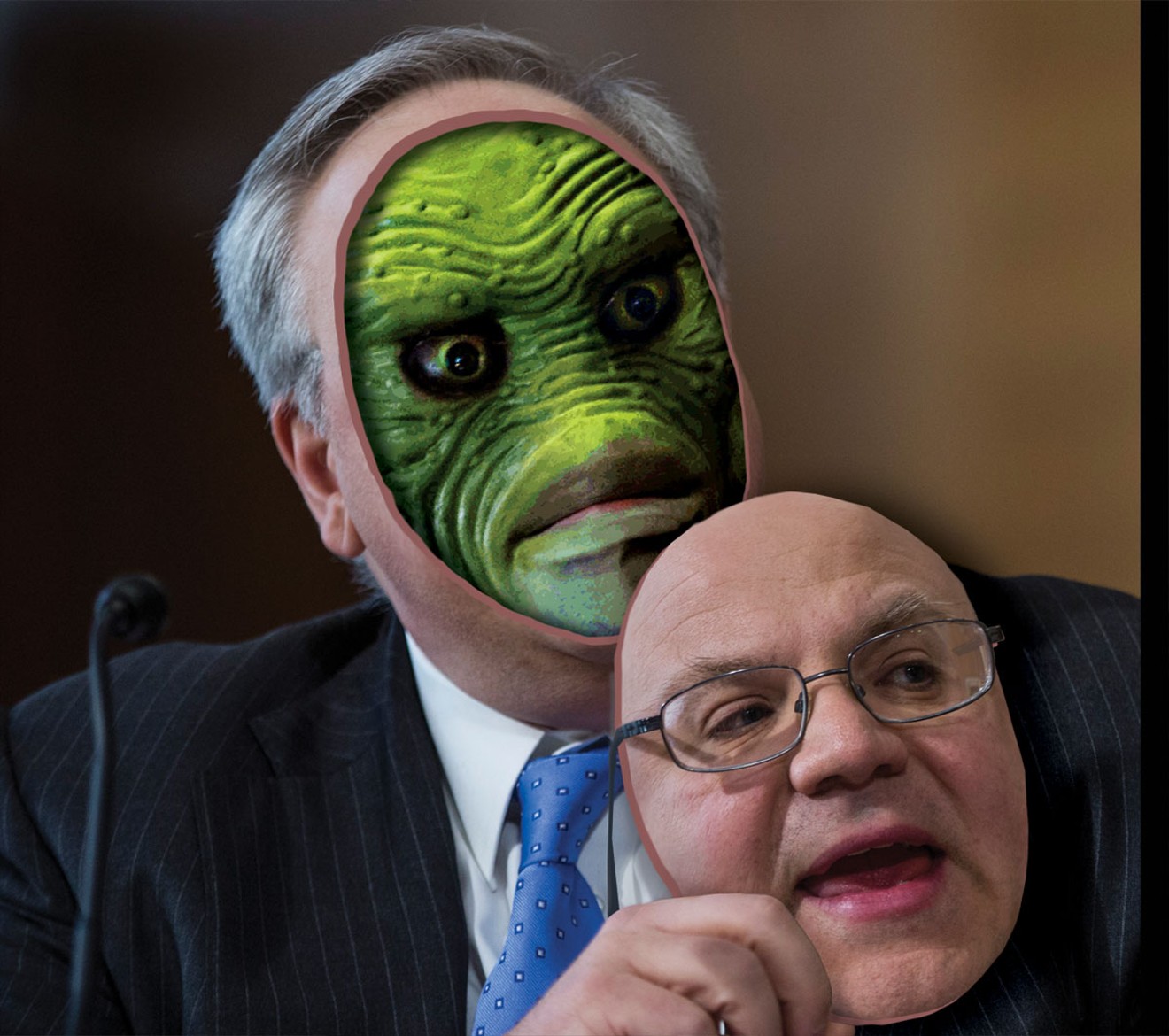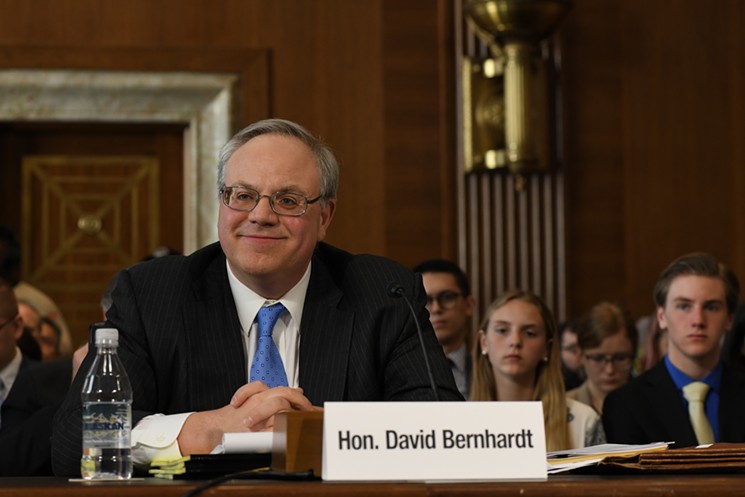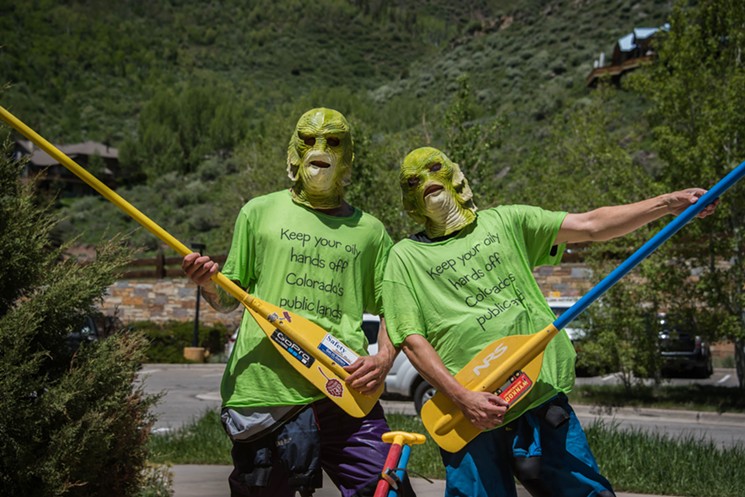Within hours of the news breaking, the party had blasted out a video dramatizing Gardner’s push for the move, which he first endorsed in 2017. “Out of the Beltway, into our back yards,” says Gardner as the ad’s royalty-free soft rock swells to a crescendo. “And these public lands will be better served as a result. Colorado will benefit. This country will benefit.”
A triumphant editorial in the Grand Junction Daily Sentinel applauded Gardner and Western Slope leaders for championing the relocation, but reserved its highest praise for another Colorado native, an oil-lobbyist-turned-Cabinet-official who’d grown up fifty miles northeast in Rifle. “None of that would have mattered if Interior Secretary David Bernhardt hadn’t endorsed the idea of a move,” the paper noted. “If we’ve learned anything about Bernhardt, it’s that he gets things done.”
But the enthusiasm waned once it became clear what, exactly, Gardner and Bernhardt had gotten done: The BLM’s plans call for just 27 jobs to move to Grand Junction, with another 58 going to the agency’s Colorado State Office in Lakewood and hundreds more to be scattered across other Western states. “A day after feeling like this was a game-changer for Grand Junction,” read the Sentinel’s next editorial, “the letdown is palpable.”
That’s not to say, however, that Bernhardt’s sweeping proposal for a “reorganization” of the BLM, which he oversees as President Donald Trump’s Secretary of the Interior, wouldn’t be a win for Republicans. In many ways, it could be the culmination of a decades-long effort, often spearheaded by Colorado-bred conservatives, to reshape federal public-lands policy. It may well be a historic achievement — but perhaps not for the reasons that Bernhardt, Gardner and others are trumpeting publicly.
“The most obvious explanation is that this is just David Bernhardt attempting to eviscerate BLM leadership,” says Aaron Weiss, deputy director of the Center for Western Priorities, a nonpartisan conservation group.
More than 95 percent of BLM employees already work in field offices spread across the West, where the agency oversees nearly 250 million acres of federally owned land. The remaining few hundred who work out of the agency’s Washington, D.C., headquarters, the vast majority of whom would move west under Bernhardt’s plan, are mostly senior civil servants, policy experts with decades of experience in navigating and enforcing complex regulatory frameworks like the Federal Lands Policy and Management Act (FLPMA) and the National Environmental Policy Act (NEPA). As with most federal workers, civil service protection laws prevent them from being easily fired.
Many of the affected BLM staffers were briefed on the reorganization just hours before the announcement, the Washington Post reported. Tensions ran high as senior administration officials told employees that they would have to uproot their families and leave D.C. before the end of next year — or leave the agency altogether.
“If you talk about getting rid of those folks, you’re talking about making it easier for David Bernhardt to just rubber-stamp everything, because of the brain drain,” says Weiss. “Losing those folks, losing those years of knowledge, is helpful if your goal is to make an end-run around FLPMA and NEPA and the Clean Water Act.”
Congressional Democrats quickly threw cold water on Interior’s proposal, and could seek to block the move by refusing to appropriate the necessary funds. But whatever the outcome of this latest fight, Bernhardt’s proposal has only stoked more chaos and uncertainty in an agency that has already had plenty of it. Two and a half years into his presidency, Trump has yet to nominate a permanent director to lead the BLM, a division that has over 10,000 employees and is the Interior Department’s second-largest after the National Park Service.
The administration’s environmentalist critics say that all of this instability is the point, however. For over forty years, Western conservatives and the powerful interest groups backing them have had federal public-lands agencies, and the BLM in particular, in their cross-hairs. In their bolder moments, they call for abolishing it altogether and transferring all or most federally owned land back to the states. On the fringes, anti-BLM sentiment occasionally even mutates into extremist views like those of Nevada rancher Cliven Bundy and his militant supporters, who confronted federal law enforcement officers in an armed standoff in 2014 and occupied the headquarters of the Malheur National Wildlife Refuge in Oregon two years later.
As with so many other Trump-era conflicts, when it comes to public-lands policy, the stakes have been raised, the boundaries pushed, the norms eroded. Longtime GOP operatives at the Interior Department are hard at work radically reshaping the way that the federal government manages much of the West, particularly with an eye toward “energy dominance,” the administration’s preferred name for its fire sale of millions of acres of land for new oil and gas development. Activists worry that Interior’s actions could have a devastating impact on the environment, wildlife protections and efforts to stop climate change — and that the consequences will be felt for decades to come.
“The ‘energy dominance’ agenda, the regulatory rollbacks, the administrative rollbacks, the expansion of leasing, even the relocation of BLM’s headquarters — they’re all attempts to buttress oil and gas,” says Taylor McKinnon, a public-lands campaigner with the Center for Biological Diversity. “A lot of what [Bernhardt] is doing are legacy moves to secure the future of oil and gas on public lands, insofar as he’s able to.”
David Bernhardt has rarely sought the spotlight during his 25-year political career, a span in which he’s completed several circuits through the revolving door between the federal government and the powerful corporate interests it oversees. After a stint working as an aide to Representative Scott McInnis, a Western Slope Republican whose 2010 run for governor was aborted after he was charged with plagiarizing an octogenarian water engineer’s work, Bernhardt quit in 1998 to join the Washington office of Brownstein Hyatt, a powerhouse law and lobbying firm based in Denver. He then held several positions in the Interior Department during the George W. Bush Administration, ultimately serving as its solicitor, before returning to his former employer — by then known as Brownstein Hyatt Farber Schreck — in 2009. He went on to chair the firm’s natural-resources law practice, lobbying on behalf of dozens of major players in energy, mining, water management and other sectors.
Environmentalists and ethics watchdogs were aghast when Bernhardt was tapped for the number-two spot at Interior in April 2017, and he quickly became a symbol of everything that critics say is wrong with the Trump administration. The Western Values Project, a conservation group, dubbed him “the ultimate D.C. swamp creature” upon his nomination to lead the department earlier this year, and his March confirmation hearing went viral thanks to images of a Greenpeace activist costumed in a green-gilled “swamp monster” mask looming over his shoulder in the gallery.
The swamp monsters have followed him to Colorado, too, rallying outside his appearance last month at the annual meeting of the Western Governors’ Association in Vail. At that conference, Bernhardt — who seldom speaks to the press and was not made available for this story — granted a rare interview to the Colorado Independent, apparently under the impression that he was speaking to the Glenwood Springs Post Independent, his hometown paper. He quickly ended the interview after realizing his mistake.
Not surprisingly, Democrats have reacted to his sweeping proposal to reorganize the BLM with concerns about what it could mean for a department they already view as overrun by ex-lobbyists and heavily under the influence of the fossil fuel and mining industries.
“This administration has been handing over public lands to fossil fuel companies at record speed, and this move is part of that agenda,” Representative Raúl Grijalva, a Democrat from Arizona and the chair of the House Natural Resources committee, said last week. “Putting BLM headquarters down the road from Secretary Bernhardt’s home town just makes it easier for special interests to walk in the door demanding favors without congressional oversight or accountability.”
Here in the West, it’s not difficult to find examples of the sort of thing that Grijalva and other Democrats might be worried about. Just a few miles from Bernhardt’s boyhood home in Rifle is the town of Glenwood Springs, where in late 2016 Denver-based mining firm Rocky Mountain Resources purchased the Mid-Continent Quarry, a small limestone mine that sits on BLM land in the hills just north of town. The quarry’s new owner soon announced plans to ask the agency to approve a massive expansion, which would increase its surface area from 20 acres to over 300 acres and could see up to five million tons of rock mined every year, up from just 60,000 tons currently.
“They want to run hundreds of trucks through [Glenwood Springs] every day,” says Weiss. “With the proper reviews, it’s probably unlikely that the folks in D.C., who know the ins and outs of those things, would give the green light for that.”
Concerned residents have formed a grassroots opposition group, the Glenwood Springs Citizens’ Alliance, but in order to stop the expansion, they’ll have to overcome the project’s close ties to Bernhardt’s former employer: Chad Brownstein, RMR’s chief executive, is the son of Norm Brownstein, founder and chairman of the board of Brownstein Hyatt Farber Schreck. In April, RMR Industrials, a division of Rocky Mountain Resources, hired Brownstein Hyatt Farber Schreck to lobby on “issues related to a potential mine expansion project in Colorado,” according to federal lobbying disclosures. RMR submitted its most recent application for the expansion earlier this month; the BLM has until August 12 to certify that the proposal is complete, after which it could begin a formal review process, with public hearings potentially held as early as next spring. By then, most of the agency’s headquarters staff could be just down Interstate 70 in Grand Junction.
“Putting BLM headquarters down the road from Secretary Bernhardt’s home town just makes it easier for special interests to walk in the door demanding favors."
tweet this
Regulatory decisions made by BLM and other Interior agencies often have much broader implications, too — as in the case of the Jordan Cove Project, a proposal by a Canadian energy company to build a natural-gas export terminal in Coos Bay, Oregon, along with a 229-mile connector pipeline to link it to existing infrastructure. The project has garnered strong support from Colorado’s oil and gas industry, which hopes to use the pipeline to market natural gas extracted on the Western Slope overseas, while climate activists argue that any new fossil-fuel infrastructure will lock in decades of harmful greenhouse gas emissions. For now, the project is on hold after Oregon regulators denied its application for a water-quality permit in May, but backers still hope to make it a reality — and one hurdle is a federal environmental-impact review, a process in which the Interior Department plays a key role.
Beginning in 2013, federal lobbying records show, Jordan Cove contracted with Portland-based Lindsey Hart and its subsidiary, FBB Federal Relations, to lobby the executive branch. But beginning in December 2018 — the same month that then-Interior Secretary Ryan Zinke resigned amid multiple ethics investigations and scandals of his own, clearing the way for Bernhardt to take over — Jordan Cove abruptly shifted course, hiring Brownstein Hyatt Farber Schreck to lobby federal agencies including Interior and the U.S. Forest Service. Paul Vogel, a spokesman for Jordan Cove LNG, said in an email that the project chose to retain Brownstein Hyatt’s services “due to its knowledge and experience,” but did not respond directly to a question on whether the decision was related to Bernhardt’s appointment as Interior Secretary.
In addition to its cooperation on the project’s environmental-impact review, the BLM administers the land on which approximately 41 miles of the Pacific Connector pipeline would be built, and would have to grant right-of-way for the project to proceed. An Interior Department spokesperson referred questions regarding the Jordan Cove project to the Federal Energy Regulatory Commission, the lead agency in the review process. Asked whether Bernhardt had recused himself from any regulatory proceedings regarding Jordan Cove, the Department sent a statement noting that the secretary “has not participated in any particular matter involving specific parties in which his former law firm represents a party.”
In an ethics pledge signed in August 2017, Bernhardt committed to recuse himself for two years from any “particular matter” involving clients of his former firm. Shortly after his confirmation this year, the Interior Department’s Office of Inspector General confirmed that it had opened an investigation into multiple complaints that Bernhardt had violated his pledge. In any case, the recusals expire next month. Coupling that with the planned reorganization of the BLM, activists fear that Bernhardt’s tenure could leave a lasting footprint on federal policy-making.
“It’s part of a broader effort to lock in industry influence,” says McKinnon. “One, by putting the agency’s headquarters in an oil and gas town. And secondly, by forcing senior staff to choose between their jobs or uprooting their families’ lives in D.C. And I think that’s an effort to repopulate the agency’s senior management with Bernhardt’s picks, who are going to be much friendlier to a pro-fossil fuel agenda.”
Americans have been squabbling over the West’s vast tracts of government-owned land for as long as there’s been a government around to claim them. But the recent fights have their roots in a series of legislative and regulatory overhauls in the 1970s. The FLPMA, a sweeping, bipartisan piece of legislation passed in 1976, formally ended obsolete practices like homesteading and affirmed that the lands administered by the BLM and other agencies would remain permanently under federal control. The law prompted fierce backlash from Western conservatives, and at least five states passed legislation claiming ownership of all BLM lands within their borders.
President Ronald Reagan swept into power in 1980 having declared himself a combatant in the “Sagebrush Rebellion,” as the movement’s adherents called themselves. Less than a year later, however, the national press had given its leaders a less romantic nickname: “The ‘Colorado Mafia’ Puts Its Stamp on the Government,” read a September 1981 New York Times headline.
Reagan had staffed his executive branch with a trio of Colorado firebrands: James Watt, founding president of the conservative Mountain States Legal Foundation (MSLF), became Interior Secretary; Bob Burford, a Western Slope rancher and former speaker of the Colorado House, was tapped to lead the BLM; and Anne Gorsuch, also a former state legislator and the mother of Supreme Court Justice Neil Gorsuch, ran the Environmental Protection Agency. (She subsequently married Burford.)
It was the dawn of a new era in public-lands policy, and in American politics writ large. The real power behind movements like the Sagebrush Rebellion, as observers noted at the time, was a group of deep-pocketed political donors including Joseph Coors, a close ally of Reagan’s who helped found the Heritage Foundation, an influential conservative think tank, in 1973. “If there is such a thing as a Colorado mafia,” an unnamed Denver Republican told the Times in 1981, “then there is no doubt that Joe Coors is the godfather.”
Watt was forced to resign in 1983 after making racist, sexist comments mocking affirmative action, and later was indicted on perjury and obstruction charges related to a federal corruption probe; in 1996 he pleaded guilty to one misdemeanor count of withholding documents and was sentenced to five years of probation. Anne Gorsuch Burford, the focus of a scandal over accusations that the EPA mismanaged its toxic-waste Superfund program, became the first agency director in U.S. history to be held in contempt of Congress, and resigned soon thereafter. By 1984, the Sagebrush Rebellion was widely judged to have been put down.
Spiritually, however, the conservative revolt against the BLM has lived on — and in many ways, so has the Colorado mafia, with a clear lineage stretching from Coors and Watt all the way through the years to Brownstein and Bernhardt. Among the attorneys who helped Watt and the MSLF form the legal backbone of the Sagebrush Rebellion was a young University of Denver law graduate named Gale Norton, who would go on to be elected Attorney General of Colorado in 1991 and later served as Interior Secretary under Bush. Norton, in turn, hired a fresh-faced Bernhardt to be her first deputy chief of staff in 2001.
While the Lakewood-based Mountain States Legal Foundation has grabbed fewer headlines over the years than Heritage and other Coors creations, it has remained a thorn in the side of environmentalists and federal regulators, mounting frequent legal challenges to laws like NEPA, the Clean Water Act, the Endangered Species Act and more. Another Reagan veteran, William Perry Pendley, led the organization for nearly thirty years before he, too, rejoined Interior earlier this month as the BLM’s deputy director of policy and programs, the agency’s number-two administrator. On his Twitter account, @Sagebrush_Rebel, Pendley — the author of books like War on the West: Government Tyranny on America’s Great Frontier — has attacked “diversity and race-based decision making” and repeatedly denied the existence of climate change.
A lot has changed in public-lands policy and the domestic energy sector since 1980, but the most seismic shift began late in Norton and Bernhardt’s Bush-era tenures. Beginning in the mid-2000s, the so-called Shale Revolution, a breakthrough enabled by advanced extraction technologies like hydraulic fracturing and horizontal drilling, led to an unprecedented boom in American oil and gas production. Towering, heavy-industrial fracking rigs spread like weeds all over the country, and public lands have been no exception; the amount of crude oil extracted from federally owned lands doubled between 2010 and 2018, according to Interior Department data.
This oil rush on public lands was overseen in part by another Colorado native — this time a Democrat, former senator Ken Salazar, who served as President Barack Obama’s Interior Secretary from 2009 and 2013 and now, in an echo of Bernhardt’s career path, co-chairs the natural-resources practice of law and lobbying giant WilmerHale. And it has come at a time when the world’s top climate scientists have issued increasingly urgent warnings about the need to drastically curb the use of fossil fuels, which are responsible for over 90 percent of climate-altering greenhouse gas emissions.
Many of the Sagebrush Rebels were small-town cattle ranchers who chafed at BLM grazing policy; now the war for the future of the West’s public lands is a high-stakes struggle between multinational fossil fuel giants and a grassroots army of environmental activists, a climactic showdown with global implications. Nearly a quarter of the greenhouse gases emitted by the U.S. can be traced to fossil fuels extracted on public lands, according to a 2018 Interior Department report.
Under Bernhardt, those production totals will only continue to rise, further accelerating the climate crisis. An analysis released last week by the Wilderness Society estimated that emissions caused by new oil and gas leases sold by the Trump administration could total over 4.7 billion metric tons of carbon-dioxide equivalent. According to EPA data, that’s comparable to the lifetime carbon emissions of nearly forty coal-fired power plants. It’s more than all 28 member countries of the European Union emit in a year, combined.
“That is a shocking number,” says Jim Ramey, the Wilderness Society’s Colorado state director. “And I think it helps create the sense of urgency that we need to reform the system and make our public lands part of the climate solution instead of part of the problem, which is what they are right now.”
Environmental groups, buoyed by a new wave of ambitious, youth-led activism, are determined to make climate change a top issue in the 2020 elections. But it’s not always easy, conservation advocates say, to communicate the importance of public-lands policy to the average voter in the West — much less in eastern states where the BLM is a non-entity. When many Americans hear “public lands,” they think of Yosemite and Yellowstone, not the millions of nondescript acres spread across western Colorado, Utah, Nevada and elsewhere, ripe for potential fossil-fuel development and increasingly on the Interior Department’s auction block.
“The Bureau of Land Management, traditionally, has flown under the radar,” says the Center for Western Priorities’ Weiss. “They’re not a marquee agency like the Park Service. BLM doesn’t come to mind for most folks. But obviously here in the West, they’re incredibly important, and manage so much more than those other agencies. So to start messing with BLM in this way should be a concern for everyone out here because of the potential for doing even worse things to Western lands.”
Many Democrats running for their party’s 2020 presidential nomination, including Massachusetts Senator Elizabeth Warren and Washington Governor Jay Inslee, have called for an end to all new fossil fuel development on public lands. Inslee’s exhaustively detailed climate plan would even direct the BLM and other agencies to “utilize all existing authorities to cancel and refuse to extend existing fossil fuel leases.” Such a move could very well be necessary to meet the emissions targets endorsed by U.N. scientists, because the leases currently being sold to oil and gas producers allow for development to begin years down the line.“The Bureau of Land Management, traditionally, has flown under the radar. They’re not a marquee agency like the Park Service. "
tweet this
“They’re trying to lock in fossil energy production for the foreseeable future,” Ramey says. “The leasing system is heavily rigged in favor of the oil and gas industry. When public lands are leased to companies, the term is for ten years, so it’s a very favorable setup for the industry, to give them flexibility to develop them at their leisure.”
In the view of many climate activists, this stockpiling of drilling rights is the unspoken motive for Bernhardt and his allies to offer up tens of millions of acres for new oil and gas development. Where administration officials claim to envision “energy dominance,” activists see a last-gasp effort by the fossil-fuel industry to prop itself up in the face of a deeply uncertain future — with the help of the longtime oil lobbyist at the helm of the country’s public-lands system.
“I think that he and the industry see the writing on the wall,” says the Center for Biological Diversity’s McKinnon. “I think that they see that fossil fuel expansion on public lands is not compatible with any semblance of rational federal climate policy moving forward. And they’re trying to approve as much leasing and as much production as they can now, before that chicken comes home to roost.”


















